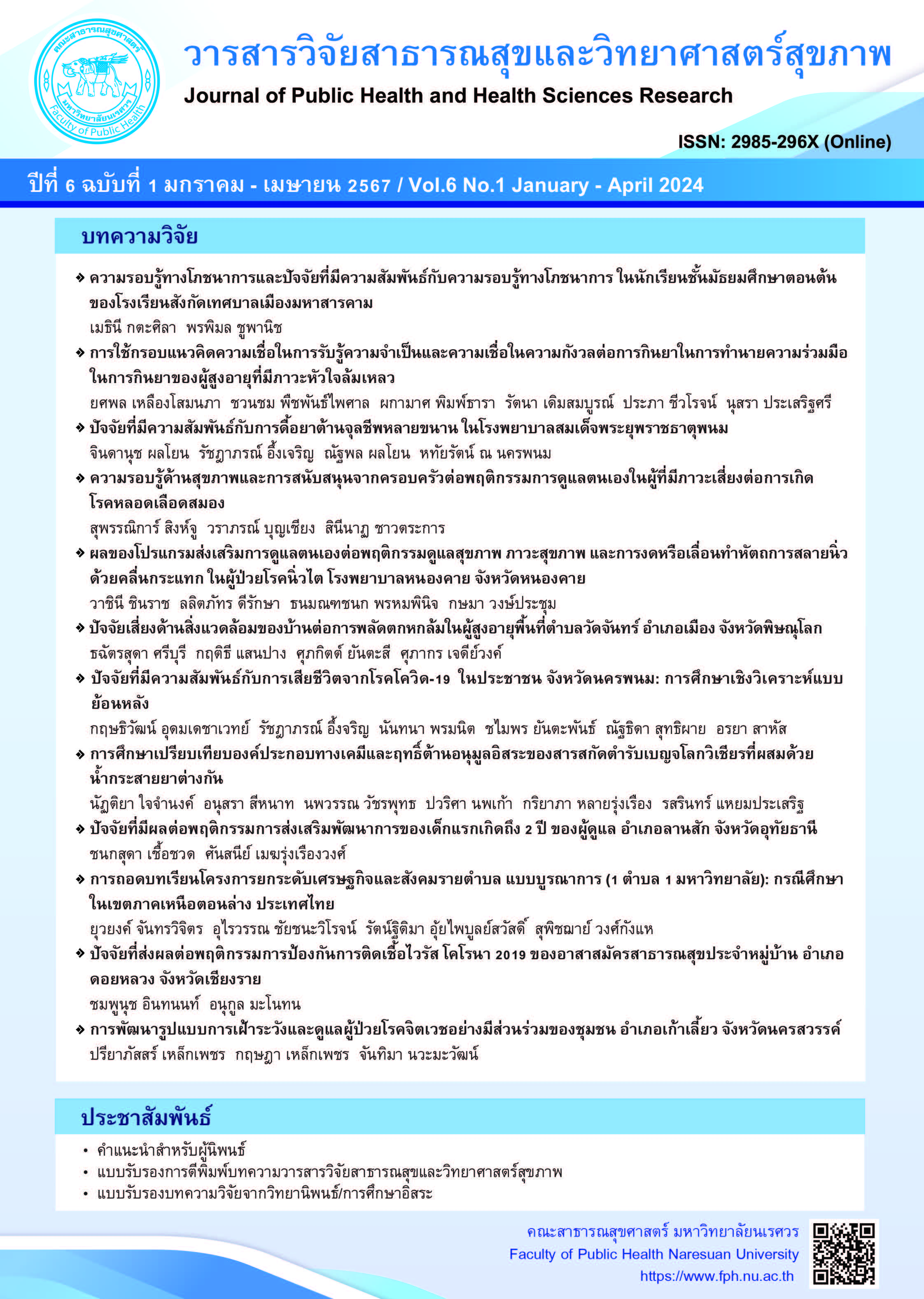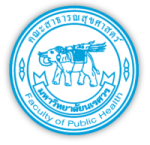การศึกษาเปรียบเทียบองค์ประกอบทางเคมีและฤทธิ์ต้านอนุมูลอิสระ ของสารสกัดตำรับเบญจโลกวิเชียรที่ผสมด้วยน้ำกระสายยาต่างกัน
คำสำคัญ:
เทคนิคแก๊สโครมาโทกราฟี-แมสสเปกโตรเมทรี, น้ำกระสายยา, ตำรับเบญจโลกวิเชียร, ยาห้าราก, ฤทธิ์ต้านอนุมูลอิสระบทคัดย่อ
ตำรับยาเบญจโลกวิเชียร เป็นหนึ่งในยารักษาอาการไข้ที่บรรจุอยู่ในบัญชียาจากสมุนไพรในบัญชียาหลักแห่งชาติ ในการรับประทานจะมีการผสมน้ำกระสายยา เพื่อช่วยให้ยามีรส สี หรือกลิ่นน่ารับประทาน ช่วยให้ยานั้นออกฤทธิ์ได้เร็วและดีขึ้น หรือช่วยเสริมฤทธิ์ตำรับยาสมุนไพรนั้นๆ การศึกษาในครั้งนี้เพื่อเปรียบเทียบองค์ประกอบทางเคมีของสารสกัดตำรับเบญจโลกวิเชียรที่ผสมด้วยน้ำกระสายยาต่างกัน 4 ชนิด ได้แก่ น้ำต้มสุก น้ำมะลิ น้ำขิง และน้ำรากผักชี ด้วยวิธี Gas Chromatography-Mass Spectrometry (GC-MS) ศึกษาฤทธิ์ต้านอนุมูลอิสระด้วยวิธี DPPH radical scavenging assay และปริมาณฟีนอลิกรวมด้วยวิธี Folin-ciocalteau' reagent
ผลการวิจัยพบว่า สารสกัดตำรับเบญจโลกวิเชียรที่ผสมด้วยน้ำกระสายยาน้ำต้มสุก น้ำต้มรากผักชี น้ำต้มขิง และน้ำต้มดอกมะลิ มีองค์ประกอบทางเคมี จำนวน 16 ชนิด 14 ชนิด 17 ชนิด และ 19 ชนิด ตามลำดับ และสารสกัดตำรับยาเบญจโลกวิเชียรที่ผสมด้วยน้ำต้มดอกมะลิและน้ำต้มรากผักชี มีฤทธิ์ต้านอนุมูลอิสระมากกว่าน้ำต้มสุก อย่างมีนัยสำคัญทางสถิติ โดยมีค่า IC50 เท่ากับ 37.62 ± 2.08 และ 42.50 ± 5.68 ไมโครกรัมต่อมิลลิลิตร ผลการศึกษาในครั้งนี้ ช่วยสนับสนุนทฤษฎีทางการแพทย์แผนไทย ที่มีการใช้ตำรับยาร่วมกับน้ำกระสายยาต่างๆ เพื่อช่วยเพิ่มประสิทธิภาพของตัวยา ทั้งนี้สามารถใช้เป็นแนวทางในการพัฒนารูปแบบยาตำรับเบญจโลกวิเชียรให้สามารถรับประทานได้ง่ายและมีประสิทธิภาพมากยิ่งขึ้น
References
Abubakar, M., & Majinda, R. R. (2016). GC-MS analysis and preliminary antimicrobial activity of Albiziaadianthifolia (Schumach) and Pterocarpus angolensis (DC). Medicines (Basel), 3(1), 3.
Asghar, S. F., Habib-ur-Rehman, Choudahry, M. I., & Atta-ur-rahman (2011). Gas chromatographymass spectrometry (GC-MS) analysis of petroleum ether extract (oil) and bioassays of crude extract of Iris germanica. Journal of Genetics and Molecular Biology, 3(7), 95-100.
Ayuravedic College (Cheevakakomalapaj). (2016). Thai pharmacy textbook. Bangkok: Pikanat Printing Center.
Gomes de Melo, J., de Sousa Arauio, T. A., ThijanNobre de Almeida e Castro, V., Lyra de Vasconcelos Cabral, D., do Desterro Rodrigues, M., Carneiro do Nascimento, S., et al. (2010). Antiproliferative activity, antioxidant capacity and tannin content in plants of semi-arid northeastern Brazil. Molecules, 15(12), 8534-8542.
Itharat, A., Reuangnoo, S., Panthong, S., Sangrapee, C., Khantham, S., Chatsuwan, J., et al. (2010). Antimicrobial and cytotoxic activities of five Thai plants used as antipyretic drug. Planta Medica, 76(12), 106.
Jeong J-Y, Jung I-G, Yum S-H, Hwang Y-J. In Vitro Synergistic Inhibitory Effects of Plant Extract Combinations on Bacterial Growth of Methicillin-Resistant Staphylococcus aureus. Pharmaceuticals. 2023; 16(10):1491.
Jongchanapong, A., Singharachai, C., Palanuvej, C., Ruangrungsi, N., & Towiwat P. (2010). Antipyretic and antinociceptive effects of Ben-cha-lo-ka-wi-chian remedy. Journal of Health Research, 24(1), 15-22.
Juckmeta, T., &Itharat, A. (2012). Anti-inflammatory and antioxidant activities of Thai traditional remedy called “Ya-harak”. Journal of Health Research, 26(4), 205-210.
Juckmeta, T., Thongdeeying, P., & Itharat, A. (2014). Inhibitory effect on β-Hexosaminidase release from RBL-2H3 cells of extracts and some pure constituents of Benchalokawichian, a Thai herbal remedy, used for allergic disorders. Evidence-Based Complementary and Alternative Medicine, 2014, 1-8.
Kamdaeng, P. (2019). Ginger: Reduce nausea and vomiting. Journal of Nursing, Siam University, 19(37), 148–160.
Kunhachan, P., Banchonglikitkul, C., Kajsongkram, T., Khayungarnnawee, A., Leelamanit, W. (2012) Chemical composition, toxicity and vasodilatation effect of the flowers extract of Jasminum sambac (L.) Ait. “G. Duke of Tuscany”. Evidence-Based Complementary and Alternative Medicine, 2012:471312. doi: 10.1155/2012/471312.
Kwanhian, W., & Bunluepuech, K. (2018). Cytotoxicity, anti-inflammation and antioxidant activities of water extracted Ya-Ha-Rak. Wichcha journal Nakhon Si Thammarat Rajabhat University, 37(special), 27-38.
National Drug Policy Group. (2023). The Thai national list of essential herbal medicine, 2023. Retrieved June12, 2023, from https://ratchakitcha.soc.go.th/documents/140D130S0000000004500.pdf (in Thai).
Nuaeissara, S., Kondo, S., & Itharat, A. (2011). Antimicrobial activity of the extracts from Benchalokawichian remedy and its components. The Journal of the Medical Association of Thailand, 94 (Suppl 7), 172-177.
Rehabilitation Foundation for the Promotion of traditional Thai medicine. Ayurvedic College (Cheevakakomalapaj). (2001). Thai traditional medical texts (medical assistance). 2nd ed. Bangkok: Samja-reunpanich.
Sakpakdeejaroen, I., Makchuchit, S., & Itharat, A.(2014). Nitric oxide inhibitory activity of herbal extract formulae for anti-inflammation. Thammasat Medical Journal, 14(1), 7-12.
Saxena, S. N., Rathore, S. S., Maheshwari, G., Sharma, L. K., & Ranjan, J. K. (2016). Analysis of medicinally important compounds and anti-oxidant activity in solvent extracts of coriander (Coriandrum sativum L.) plant parts, Journal of Spices and Aromatic Crops, 25(1), 65-69.
Tephtong, P., Junthong-oon, J.,Prajuabjinda, O.,Reuangnoo, S.,&Itharat, A. Comparative study of antioxidant activity and total phenolic content of ethanolic extracts of ginger, black pepper and long pepper.In Trakulwaranon, P. (ED). Proceeding of of 1st Conference on Graduate Student Network of Thailand (GS- NETT 2012). (pp. 60). Bangkok: Thammasat University.
Thongmak, K., Janpat, T., Chandang, R., Marde & Noipha K. (2021). Preliminary phytochemical study and antioxidant activity of five flowers remedy. Journal of Traditional Thai Medical Research, 7(2), 61-74.
Tripatara, P., Akarasereenont, P., Panich, U., & Chandranipapongse, W. (2013). The antioxidant, antiplatelets, and anti-inflammatory effects of AyurvedSiriraj Ha-Rak recipe. (Research report). Thailand Science Research and Innovation (TSRI).
Downloads
เผยแพร่แล้ว
How to Cite
ฉบับ
บท
License
Copyright (c) 2024 วารสารวิจัยสาธารณสุขและวิทยาศาสตร์สุขภาพ

This work is licensed under a Creative Commons Attribution-NonCommercial-NoDerivatives 4.0 International License.
บทความที่ได้รับการตีพิมพ์เป็นลิขสิทธิ์ของวารสารวิจัยสาธารณสุขและวิทยาศาสตร์สุขภาพ
ข้อความที่ปรากฏในบทความแต่ละเรื่องบทความในวารสารวิชาการและวิจัยเล่มนี้เป็นความคิดเห็นส่วนตัวของผู้เขียนแต่ละท่านไม่เกี่ยวข้องกับมหาวิทยาลัยนเรศวร และคณาจารย์ท่านอื่นๆในมหาวิทยาลัยฯ ความรับผิดชอบเกี่ยวกับบทความแต่ละเรื่องผู้เขียนจะรับผิดชอบของตนเองแต่ละท่าน






